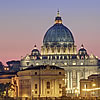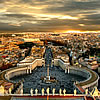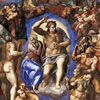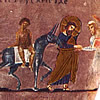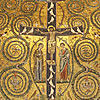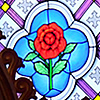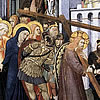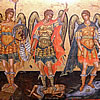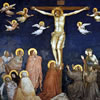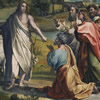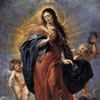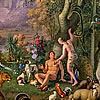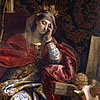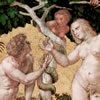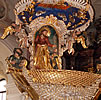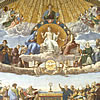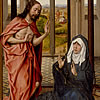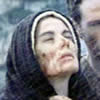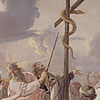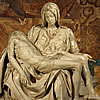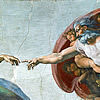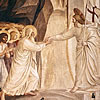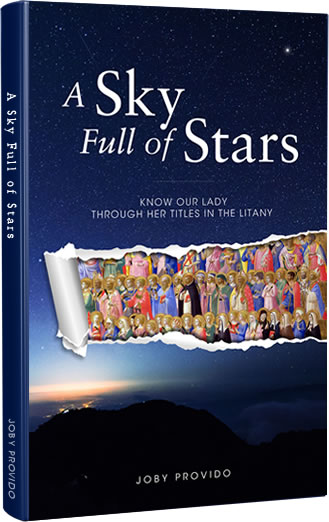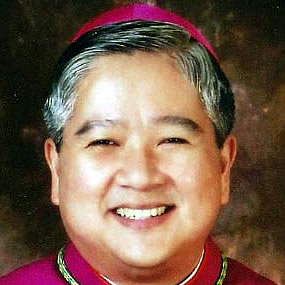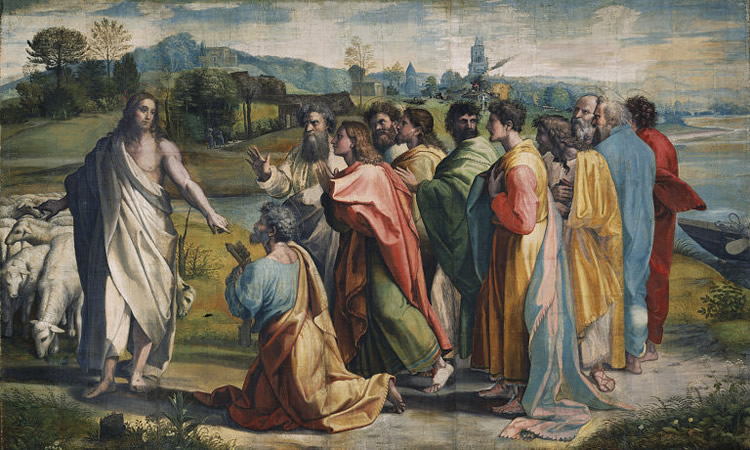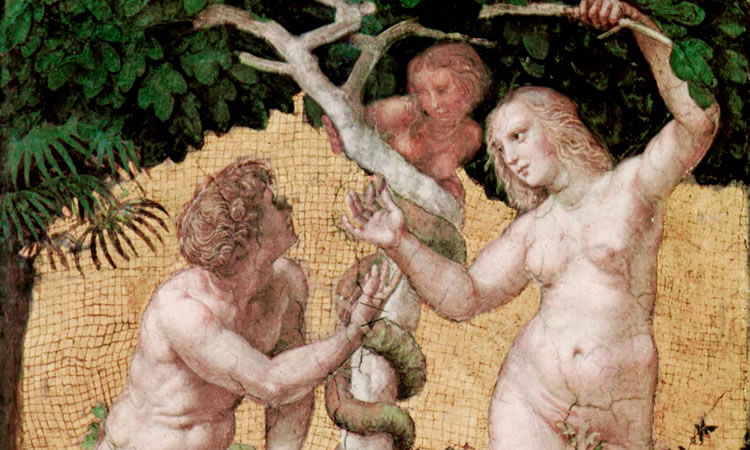

Disputation of the Holy Sacrament
The Disputation of the Holy Sacrament – also known by its nickname the Disputa – is a fresco of an allegory for Theology found in the Hall of Signatures in the Vatican together with three other frescoes. The one directly opposite the Disputa is entitled The School of Athens as an allegory for Philosophy (or Science). The other frescoes are allegories for Poetry, and Jurisprudence (Law) in the adjacent walls. The room was originally used as a library and as a special room where the Pope would sign important documents, which is how the room got its name. The Disputa expresses four things at the least: the Communion of Saints, the Holy Spirit’s relationship with the Father and Son, the Real Presence, and the mystery of Theology.
The Communion of Saints
Two of the first things that are very noticeable are two horizontal planes: the heavenly and the earthly. In the heavenly plane we see from left to right St. Peter (holding the keys), Adam, St. John the Evangelist, King David, St. Laurence, Judas Maccabees, St. Stephen, Moses (with rays coming out of his face), St. James the elder, Abraham, St. Paul (holding a sword), with Christ in the center. On the earthly plane, we see personages such as Plato (holding his Timaeus), Aristotle (holding his Ethics), Socrates, Heraclitus, Digoenes, Euclid, Zoroaster, and Ptolemy. We also see four Doctors of the Church: Pope Gregory I, Jerome, Augustine, and Ambrose. It is a reflection of what Catholics believe is the Communion of Saints. Basically, it means that all members who belong to the Church are one – a union – with each other through Christ. Christ is the vine, and the members of the Church are the branches. Saint Paul would refer to the early Christians as “saints” or “holy” since we are temples of the Holy Spirit who makes us holy. Physical death does not change one’s union with Christ and the Church. So here in this fresco, we see the Church both living and “dead” fully alive, in different planes, and yet one.
The Holy Spirit Proceeds from the Father and the Son
Another thing that is easily seen is the vertical alignment of the Father, the Son, and the Holy Spirit in the middle of the fresco. Years prior to this fresco, there was an argument on the relationship of the Holy Spirit with the Father and Son. The question was did the Holy Spirit come solely from the Father, or both Father and Son. It has been a long-standing Tradition of the Church Fathers, Councils, and Popes that the Holy Spirit proceeds from the Father and from the Son. It is the “filioque” clause (meaning “and from the Son”) that we profess in the Nicene Creed. We believe that the three persons of the Blessed Trinity are distinct, and we can glean that from their origins: The Father has no origin, the Son comes from the Father, and the Holy Spirit comes from the Father and from the Son. We have to remember that God has no beginning, so none of the persons of the Blessed Trinity have a beginning. So when we speak of origin, we are speaking in terms our finite minds can understand.
The Real Presence
In the fresco we see vertical similarities in the figures as if showing that what is in heaven is also on earth. On the left of Christ is the Virgin Mary whose hands are pressed near her chest. Below her, on the earthly plane, there is a person right beside the table with the exact same expression. On the right of Christ is Saint John the Baptist with his hand raised up. Below him is Julius II also with his arm raised up in the same fashion. As you go left and right of both planes, you will see figures above with their equivalents below. This brings us to the middle of the fresco where we have God above and the equivalent on earth is the Blessed Sacrament painted as a white host inside a monstrance.
Catholics believe that Jesus is truly present in the Blessed Sacrament. It is not just a symbol of Christ, but Christ himself. So the Host is the body and blood (because body has blood), and, therefore, contains the soul and divinity of Christ. Chapter six in the Gospel of John records Jesus teaching in the Synagogue that we must eat his body and drink his blood. Many disciples left because they understood he was teaching something that was literal and not just talking symbolically. If cannibalism was reviling for a Jew, even more so was the drinking of blood which was prohibited. But during the Last Supper, Christ changed the bread into his body, and wine into his blood and commanded them to “do this in memory of me.” We know the apostles understood it this way because we read the early Christians in Acts were “breaking bread” – a form of “cannibalism” they were being persecuted for.
The Mystery of Theology
We come to the main allegory of the fresco: Theology. In the fresco, Raphael shows individuals discussing the Eucharist – and it is no dull conversation. Hands are pointing and certain people with their noses buried in books as if searching for something. The word disputation does not necessarily mean disagreement. It can mean a formal argument to understand things. In fact, they are having an animated discussion about the Mass and the Host on the altar.[1]
For Catholics, the Eucharist is the source and summit of Christian life, for if we find an encounter with Christ in the sacraments, the Blessed Sacrament is Christ himself. The heated argument in the fresco is focused trying to understand how Christ is in the Eucharist. Catholics believe in transubstantiation. That is when a priest acts in the person of Christ and says, “this is my body”, “this is my blood” the bread and wine turn into the body and blood of Christ respectively. While the materials (or technically called accidentals) are still bread and wine, the substance – the thing that a thing is – is no longer bread and wine but the body and blood of Christ. Raphael puts the host in the dead-center of the fresco as a way to illustrate this visually. In fact, the monstrance containing the host is the vanishing point (the point where all lines meet) if you trace the tiles on the floor.
By painting the host in the center of the fresco, it also indicates in a visual way, that the Eucharist is the link between heaven and earth. In Revelation we read of a heavenly worship that has all the elements of the Mass. In fact when we sing “Holy Holy Holy” during the Liturgy of the Eucharist, we are in fact joining the angels in heaven for it is their song (Revelation 4:8)
The depiction of an on-going argument does not mean Catholics cannot agree on what the Eucharist is. What it reflects is that there are some things we acknowledge we can never fully understand. These are what Catholics refer to as theological mysteries. They are not mysteries in the sense that they are puzzles to be solved. Instead, they are things that cannot be completely understood. Just because they cannot be understood does not necessarily mean they are against reason (or what we would refer to as irrational.) Instead, they are super-rational – something that is above the capability of our natural reasoning. They are supernatural truths that can only be contemplated through the eyes of the mind and the gift of faith. This is, according to Raphael’s fresco, is what Theology is.
The interesting thing that Raphael does is to paint the Disputa opposite The School of Athens – his allegory for Science.
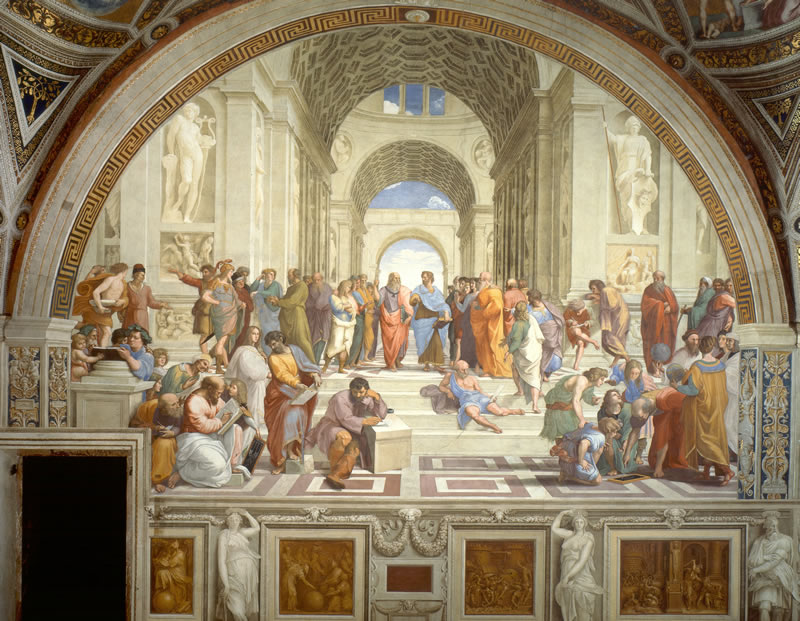
In it we see vaulted ceilings and a closed space that symbolizes the borders of Science. However, in the Disputa, Theology is depicted as an open space with no borders. The fact is, the Church is not made up of stone, but of people. One cannot help but see how it fulfills Jeremiah’s prophecy:
See, days are coming—oracle of the LORD—when I will make a new covenant with the house of Israel and the house of Judah.
It will not be like the covenant I made with their ancestors the day I took them by the hand to lead them out of the land of Egypt. They broke my covenant, though I was their master—oracle of the LORD.
But this is the covenant I will make with the house of Israel after those days—oracle of the LORD. I will place my law within them, and write it upon their hearts; I will be their God, and they shall be my people.
They will no longer teach their friends and relatives, “Know the LORD!” Everyone, from least to greatest, shall know me—oracle of the LORD—for I will forgive their iniquity and no longer remember their sin.
Jeremiah 31:33
The word Testament means Covenant, and in the Old Testament (or Old Covenant) the law was written in stone. This of course alludes to the stone tablets of the Ten Commandments. The Shekinah, or presence of God was found inside the stone Temple in Jerusalem. However Christ changed all that in the New Testament. The Church that Christ established is not confined by a building structure or geography. The Church is made of people who respond to God’s call and therefore obey his laws with their hearts. This is why when Christ told Peter he is the rock of the Church, the other apostles understood he was the pillar that would support the others because the Temple in Jerusalem was built on a large rock (where today a church-turned-mosque called The Dome of the Rock sits on.)
In the Old Testament, God’s people would always break their part of the covenant by worshipping other gods again and again. This is why biblical poetry always presents God as a faithful husband, but her bride (Israel) as a prostitute who would go with other gods. But Christ changed all of that too. Covenants are made when two people give each to the other. An animal would be cut up and its blood spilled on the ground alluding that if one of the parties break the covenant, they would end up like the butchered animal. When Christ died on the cross, he was the priest who offered God a sacrifice, and he is the sacrifice as well.
At the same time, Christ also represents all of mankind in a covenant where we give ourselves to God, and God give himself to us. He is the animal butchered and blood spilled in the covenant ritual. He refers to this during the Last Supper when he said, “This is my blood of the covenant, which will be shed for many.” (Mark 14:24) When this is re-presented in the Mass, we have the opportunity to consent and allow Christ to represent us as we offer ourselves to God in union with Christ who offers himself.
As we can see, there is more going on in the Mass than it seems to the naked eye, so we can understand why it and the Eucharist will always be a source of awe and wonder (mystery) forever. In the Disputa, Raphael seems to express that no amount of rationalizing will make us understand some aspects of Theology, which means we need to accept there are things that will always remain above our understanding – a mystery.
[1] Gorpgp Vasari – Commenting on the Disputa in the 1500’s



